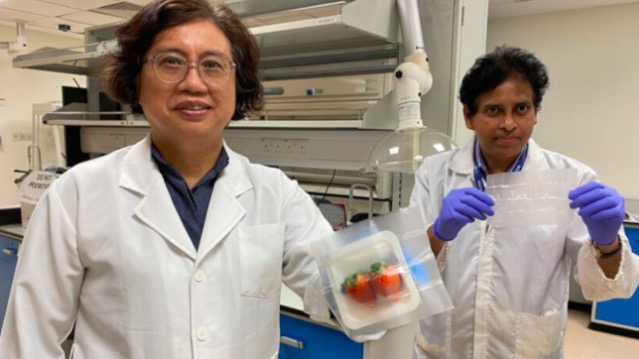Scientists invent biodegradable bacteria-killing packaging

When exposed to an increase in humidity or enzymes from harmful bacteria, the fibers in the packaging release the natural antimicrobial compounds, killing common dangerous bacteria that contaminate food, such as E. coli, Listeria or fungi.
The packaging is designed to release the necessary amount of antimicrobial compounds in response to the presence of additional humidity or bacteria. This ensures that the packaging can endure several exposures and last for months.
As the compounds combat any bacteria that grow on the surface of the packaging as well as on the food product itself, it has the potential to be used for a large variety of products, including ready-to-eat foods, raw meat, fruits and vegetables.
According to the scientists, an experiment showed that strawberries that were wrapped in the packaging stayed fresh for seven days before developing mold, compared to counterparts that were kept in mainstream fruit plastic boxes, which only stayed fresh for four days.
Chan said that their material will cost about 50 percent more than ordinary plastic packaging.
Having an antibacterial and biodegradable alternative for food packaging could be hugely beneficial for waste reductions and food safety. According to the U.S. Environmental Protection Agency, containers and packaging make up a major portion of municipal solid waste, amounting to 82.2 million tons of generation in 2018. Packaging is defined as the products used to wrap or protect goods, including food, beverages, medications and cosmetic products.
The new packaging is intended for food items such as raw meat, fish, fruit, vegetables and ready-to-eat meals. Professor Mary Chan, the director of NTU’s Centre for Antimicrobial Bioengineering who co-led the project, says the team’s aim is to replace conventional plastic packaging with the new material that will also double the shelf life of produce.
“Vegetables are a source of wastage because even if they are refrigerated, they will continue to respire, leading to spoilage after a week or two. With the antimicrobial packaging, there is a chance to extend their shelf life. . . and also make the vegetables and fruits look fresh with time,” she said.
Companies that are looking at potentially using the new invention will have to evaluate the cost-effectiveness of extending their products’ shelf life.
